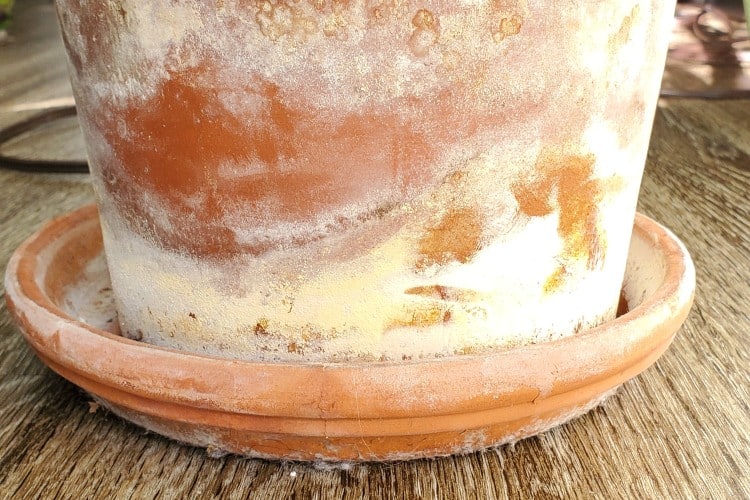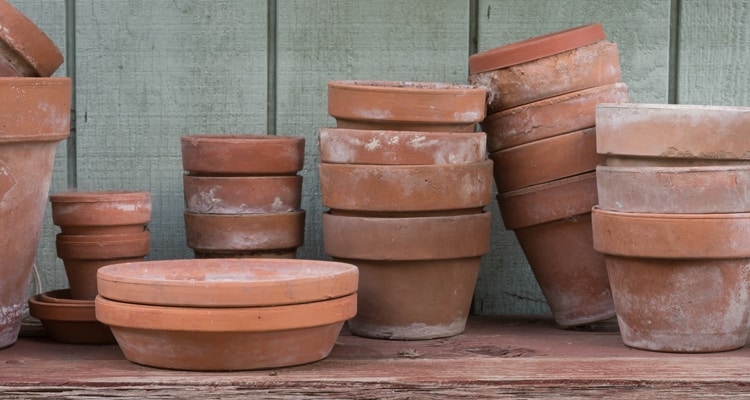Terracotta pots are one of the most popular types of pots for growing plants indoors or out in the garden. This type of pot has many effects in releasing air, draining water, and avoiding waterlogging for plants. In addition, many people love terracotta pots because of their classic beauty and environmental friendliness. Many plants look much more attractive if you grow them in simple terracotta pots.
The advantages of terracotta pots can be many in terms of plant health and the ability to decorate your home. However, if you use terracotta pots to grow plants, you will face mold. White mold on terracotta pots will be common in wet spots in your area. So you need to learn some insight into this condition and how to safely and effectively remove mold from terracotta pots.
White Mold On Terracotta Pots – How To Distinguish
You see white streaks or white spots on terracotta pots and believe it to be mold growth. However, you need to be precise because mold can be mistaken for salt that accumulates on terracotta pots. In addition to the appearance of mold, mineral salts can also cause white patches to appear on pots.
Unlike pots made of plastic or glass, mineral salts can accumulate on the outside of terracotta pots because water can seep through the terracotta. Therefore, dissolved flowers, salts, and fertilizers can accumulate on the surface of the pot. Especially, if you regularly use tap water to irrigate plants. As the water evaporates and exits the earthenware pot, the solids will stick to the outside surface of the pot.

How To Distinguish Mold And Mineral Salts?
White streaks for long-term accumulations clinging to the pot wall: When you touch the white patches and feel that they are dry, and rough and have not changed in appearance. The white patches will feel flat on the surface of the terracotta pot and fall to the ground when you touch it. You can see white patches that are uniform and cover the whole area instead of scattered in spots.
Mold on terracotta pots: You can notice mold by observing with the naked eye at an angle. Mold is usually wet and has tiny hairs on its surface. You just need to lightly touch the white patches and they will change shape. The reason is that the force from the finger will damage the fungal spores and they will collapse. Mold will also appear as scattered spots on the surface of the terracotta pots. Small circles will appear and grow over time.
For accumulations such as mineral salts or compounds on the surface of the earthenware pot, simply use a towel to wipe it off. As for mold, when the air is drier and hotter, the mold will die. However, the fungal spores will persist and wait for the ideal wet conditions to continue to grow year after year.
Do I Need To Get Rid Of Mold On Terracotta Pots?
Many people think that mold appearing outside the terracotta pots will not affect the health of the plants. So they don’t have to worry about it. However, mold not only affects the health of plants but also directly affects human health. People and pets will experience breathing problems if they breathe in the mold on the terracotta pots.
Mold can also spread to other potted plants or damp areas of your room through the overgrowth of fungal spores. Therefore, it is very easy for people and pets to breathe in the fungal spores that fly around in the house. Some of the human symptoms of inhaling fungal spores are a stuffy nose, sore eyes, or skin problems. In severe cases of pollution, you can get dangerous lung diseases because mold can go directly into the lungs and cause infection.
So, while mold may not have much of an effect on the health of your potted plants, you still need to get rid of them to protect the health of people and pets. Remove airborne fungal spores to avoid spreading to other plants in your room. Inhaled spores can cause symptoms such as nasal congestion, irritated eyes, and skin problems. In severe cases, mold can sometimes get into our lungs and cause an infection.

How To Remove Mold On Terracotta Pots?
You should only use specialized drugs to kill fungi with an empty terracotta pot. The reason is that chemical drugs will still affect the health of plants even if you act outside the pot. Chemical drugs will still penetrate the soil and destroy beneficial microorganisms in the soil. So, remove plants from pots before using methods to remove mold. Here are some steps you need to take to get rid of mold.
Use Specialized Fungicides
- Use a separate spray bottle to mix the fungicide with water in the ratio recommended by the manufacturer printed on the product packaging.
- You can soak an entire terracotta pot in the solution for about 10 minutes.
- Spray the mixture on the inner, outer, and perineal surfaces in turn.
- Use a stiff bristle brush to clean and rinse under running water.
- Repeat the process of soaking and scrubbing off the white patches on the outside of the pot until they are completely gone.
Use Hydrogen Peroxide Solution
- Use only 3% Hydrogen Peroxide solution. Do not abuse to use higher-concentration solutions as they can kill your plants.
- Pour 3% Hydrogen Peroxide solution into a separate spray bottle.
- Spray directly onto all pot surfaces and areas with white patches.
- Hydrogen Peroxide and mold will react and form bubbles.
- Use the cleaning tool to wipe and scrub the surface of the terracotta pot.
- Rinse thoroughly under running water to completely remove mold and solution.
Clean Mold With Vinegar
Vinegar is one of the solutions derived from nature and is often applied to remove fungi safely for the health of plants and humans.
- Soak the entire terracotta pot in a container after you’ve cleaned it with water.
- Add a mixture of water and vinegar in a 1:1 ratio until the terracotta pot is submerged.
- You should soak the pot in this mixture for about 30 minutes.
- Remove the pot from the container and use a stiff bristle brush to clean the surrounding area.
- Repeat the soaking and scrubbing process until the white spots are completely gone.
- Let the terracotta pot dry completely before replanting the plant in the pot.
How To Prevent Mold Growth On Terracotta Pots?
The mold that occurs in plants and terracotta pots both originates from a humid environment. A humid environment is an ideal environment for fungi to grow. Fungal spores are always available in the air and they are just waiting for wet conditions to thrive. So to prevent mold from growing on terracotta pots, you need to keep the environment dry and well-ventilated. Here are some tips you need to take to get rid of mold in your home.
Use a humidifier: A humidifier works to maintain the ideal humidity in your home. So you won’t have to worry about too much humidity causing mold to grow quickly. Localized humidifiers will only maintain the ideal humidity in the area you desire. So it won’t change the humidity in the house and affect different plants.
Proper watering: Over-watering potted plants is also the leading cause of mold growth. Waterlogging keeps the soil moist and creates favorable conditions for mold growth. In particular, humidity and waterlogging are also the most ideal environments for fungal spores to quickly parasitize the leaves of plants and attack the cells of the leaves.
Improve drainage: Terracotta pots need to have at least one drainage hole to remove excess water during your watering. If the excess water drains from the pot, it will help keep the soil dry and prevent harmful bacteria from attacking. As a result, the terracotta pots will not be waterlogged, and mold will grow around the pot.
Open space and air circulation: Air cannot circulate to the outside which is also the cause of mold growth. You should place the potted plant in a place with good air flow, and sunlight to dry the leaves and soil quickly when you water. The air circulation also helps clear fungal spores in wet areas.
The Last Word
Mold can appear on terracotta pots due to the humid environment. However, you need to accurately determine the presence of mold or mineral salts. Mineral salts and other compounds found in tap water can also form white patches around terracotta pots. You need to get rid of these molds because they will seriously affect the health of people and pets.
You can use specialized fungicides, vinegar, or Hydrogen Peroxide solution with a concentration of 3%. Soak the terracotta pots in these mixtures for 10 to 30 minutes and use a stiff-bristled brush to clean them. After that, you need to rinse with water several times until the white patches are gone.
To prevent mold from growing on terracotta pots, you need to water them properly to keep the soil dry and aerated. Improve drainage to prevent waterlogging and place potted plants in an area with good air circulation. Maintaining the right humidity is also a way to get rid of fungal spores from the air. Thank you for listening!